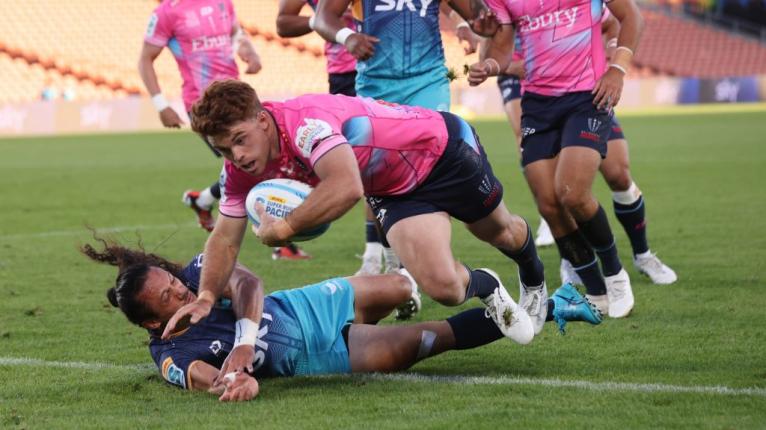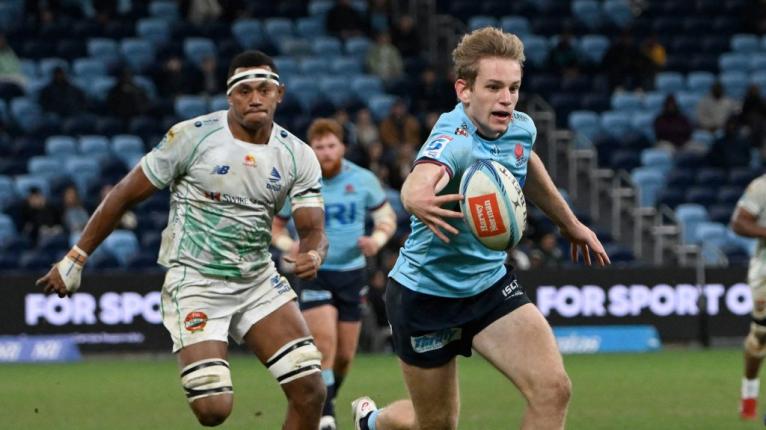When Joseph-Aukuso Sua’ali’i, Andrew Kellaway and Max Jorgensen first cross paths at the gleaming new NSW Rugby Union Centre of Excellence in Daceyville in 2025, there are likely to be some firm handshakes, and not a few nervous glances exchanged.
The problem is the trio all favour the same position on the field, at full-back. Wallaby incumbent Kellaway has signed from the endangered Melbourne Rebels on a three-year deal which will take him up to the 2027 World Cup. The financial incentive for the move must have been significant enough to reverse the nagging feeling Kellaway experienced after the 2023 World Cup
“To be honest, it broke me a bit towards the end there,” he said. “A couple of weeks after that, I was like: ‘How do I get out of here? How do I get out of Australian rugby?’”

Eight months earlier, ex-Rugby Australia chairman Hamish McLennan had locked down Sua’ali’i in a high-profile transfer from the NRL. Sua’ali’i is a leaguer without any professional background in union, but he was to be paid around $5m AUD over three years for his services.
According to Daily Telegraph journalist Phil Rothfield, the same piece of business could have been done in 2018 for a paltry $100K per annum:
“Even with a contract upgrade and an extension beyond that original term, Rugby Australia would not be paying anything like the $4.8 million they have now been forced to cough up for the 19-year-old to switch codes for the 2025 season. It is another indication of how the code refused to invest in their best juniors and pathways.”
Perhaps mindful of the need to raise the stakes with league earlier in the hand, Rugby Australia tabled a $1.6m offer over three years for Max Jorgensen at the end of March, to ease the 19-year-old away from the obvious attraction of playing for his father Peter’s club, the Roosters.
That is more than established union stars such as Kellaway and the Brumbies’ Tom Wright currently earn. Young ‘Jorgo’ is already thinking Lions in 2025, and World Cup in 2027:
“I obviously love the game. I want to make my mark here [in New South Wales], play for the Wallabies, and obviously [a] British and Irish Lions [tour] comes around every 12 years.
“That’s a dream playing at a World Cup for the Wallabies – and with the Lions – if you miss that, you don’t really get another opportunity to do it again.”

In the event, Jorgensen signed a two-year extension to his current deal with RA, with the likelihood of an upgrade to the ensure his participation in the 2027 World Cup.
If Jorgensen is indeed a ‘Wallaby-in-waiting’, the presence of no fewer than three national contenders for the same spot at the same club underlines the lack of forward thinking in Australian rugby. The inflated salaries offered to two of them only aggravates an already uneasy situation. How can Rugby Australia reclaim control of its own wage scale when unproven properties, however ‘hot’, are already busting the cap it is trying to introduce?
In Jorgensen’s case, injuries are also a concern. The youngster was selected in Eddie Jones’ World Cup squad while in the process of recovering from a long-term knee injury, only to suffer a fractured fibula which ended his dream mid-tournament.
The presence of Sua’ali’i, Jorgensen and Kellaway at the Waratahs ignites multiple questions, like sparks thrown off a catherine-wheel. Are Sua’ali’i and Jorgensen really worth the money invested in them? Would at least one of the two newcomers not be better positioned at a franchise which really needs a full-back, such as the Force?
Will either have enough opportunities to gain the experience necessary to displace Kellaway – or for that matter Wright – in Joe Schmidt’s Wallabies before the Lions arrive in just over 15 months? Will they receive the right coaching support to maximise their potential?
The weekend match between the Brumbies and the Waratahs suggested the systems in place in New South Wales stand little chance of developing Jorgensen into a Test-standard full-back in just over one calendar year, and it is a salutary lesson for Australian rugby as a whole.
Let’s start with defence. As early as the 13th minute, the system was hampering rather than helping Jorgensen’s ability to show up well as a defensive full-back.

As the wide angle from behind the posts illustrates, the three key attackers for the Brumbies – playmakers Noah Lolesio, Wright and speedster Corey Toole [behind the set-piece] – are all aligned to the left of the scrum from an NSW viewpoint. The attack is obviously going left, but Jorgensen is defending on the wide right, which means he will be late to the scene of the action as the play unfolds. Jorgensen will probably cop the blame if the Brumbies score, but it is the system which put him there.
The Brumbies made no mistake when they achieved a similar overload in the final quarter.
Once again, all the key attackers [Lolesio, Wright and Toole] are stacked on the same side in a six-vs-four only 20 metres from the goal-line. As the last defender, Jorgensen’s only hope is to keep coming upfield and shut down the play on Toole, man-and-ball. But the two New South Wales defenders on the outside [Jorgensen and Mark Nawaqanitawase] barely manage three steps forward before they take root and wait for the inevitable to unfold, with veteran prop James Slipper chuckling gleefully in commentary.
The full-back’s positioning at restarts was equally mystifying.

This was one of three occasions when the Tahs struggled on deeper kick-offs to their left, with Jorgensen oddly out of play – spotted high in centre-field, closer to the 40m line than the 22. It is left to the two NSW centres to clear up the mess in the backfield, but Jorgensen needs to be doing what his jersey number says on the tin.
It was not much better with ball in hand. Jorgensen was not utilised at all as an extra first receiver and the height of his passes off his right hand probably showed why. They tended to hit the receiver high, at shoulder or head level.

In the screenshot, Tane Edmed has to stretch high above his head to receive the pass from Jorgensen on a kick return, and that means there is no possibility to move the ball further out. Likewise, the pass on Dylan Pietsch’s shoulder forces him to take the route inside rather than granting the option of exploiting space down the sideline.
Jorgensen also made a couple of poor decisions on the offload after making a mini-break.
In both cases, he throws the ball away blind after making the initial bust, offering the Brumbies inviting opportunities on the turnover counter.
If he is to become a worthy successor to James O’Connor as the most exciting teenager of his generation, Jorgensen will need to receive the coaching guidance which allows him to make better on-field decisions. In the current Waratahs environment, the results suggest he is not getting the support he needs.
After a long break by Edmed, Jorgensen is on hand and the right play is to link with Joey Walton and Nawaqanitawase outside him. Instead, he unaccountably turns back inside and play returns to structure with another forward carry by Fergus Lee-Warner. If there is one thing an outside back must be able to do at international level, it is to sustain momentum when those priceless opportunities against an ‘unstructured’ defence present themselves.
If Rugby Australia is to return to anything approaching normality, it needs to gain control of its wage structure and create the right development programmes which enable youngsters such as Jorgensen to prosper. Paying out more for a wistful promise of success, and less for proven value, does not make much sense, and creating a logjam in the full-back position compounds the problem.
If the systems in place cannot put him in the right spot to make a play, or educate the decision-making process once he has gets there, ultimately it is Max Jorgensen who will cop the blame, and that will not be right. If there is one thing Australian rugby cannot afford now, either literally or figuratively, it is another exorbitantly expensive busted flush.



Comments
Join free and tell us what you really think!
Sign up for free